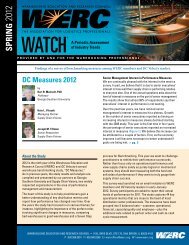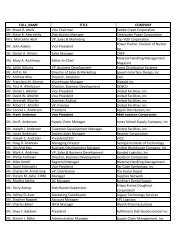Calculating Warehouse Inventory Turnover - WERC
Calculating Warehouse Inventory Turnover - WERC
Calculating Warehouse Inventory Turnover - WERC
You also want an ePaper? Increase the reach of your titles
YUMPU automatically turns print PDFs into web optimized ePapers that Google loves.
An Association ofDistribution Professionals1100 Jorie Blvd., Ste. 170Oak Brook, IL 60523-4413Phone: 630-990-0001Fax: 630-990-0256E-mail: wercoffice@werc.orgWeb: http://www.werc.org<strong>Calculating</strong> <strong>Warehouse</strong> <strong>Inventory</strong> <strong>Turnover</strong>Article Date: 11/1/1999<strong>Inventory</strong> turnover is best thought of as the number oftimes that an inventory "turns over" or cycles throughthe warehouse in a year. <strong>Inventory</strong> turnover of 12means the average inventory moves through thewarehouse once per month; turns of 6 times means theaverage inventory cycles through the facility every twomonths. <strong>Inventory</strong> turnover can be improved by eithermoving the same amount of product through thewarehouse with a lower average inventory or movingmore product through the warehouse with the sameaverage inventory.The inventory turnover measure is a ratio of flow toaverage inventory. As such, it is somewhat of anabstract concept. Days of supply is another, morestraightforward, way of viewing inventory turnover.<strong>Inventory</strong> turnover and days of supply are related: if theinventory turns 4 times per year, or once every 3months, then 4 turns equates to a three-month or 90-day supply of sales. Twelve turns equates to aninventory of 30 days of supply.Correct Calculations Are CriticalBecause inventories represent a sizable investment ofcompany funds and larger inventories mean highercarrying costs (space, insurance, taxes, capital costs,etc), a common inventory management goal focuses onimproving inventory turnover.EXAMPLE: A firm’s inventory currently turns over 6times per year, and the firm’s annual unit flow throughthe warehouse is 180,000 units. The firm’s averageinventory is 180,000/6 or 30,000 units. Assume thecarrying cost of inventory is 25% and the cost of a unitis $10. The inventory investment is 30,000 x $10 =$300,000. The annual inventory carrying cost is$300,000 x .25 = $75,000.If the firm increases inventory turnover from 6 to 9 turnsper year and maintains the same level of product flow,the average inventory would be 180,000/9 = 20,000units or $200,000. There are two important influences atwork here. The firm will:1. Experience a $100,000 reduction in the cashinvested in inventory.2. Have operating savings based on a reduction incarrying costs. Carrying costs will now be $200,000x .25 = $50,000 per year, which equates to anannual savings of $25,000 ($75,000 - $50,000).As the example demonstrates, inventory turnover is acritical performance metric to assess the effectivenessof inventory management. Because it is so extensivelyused as a diagnostic tool, it is imperative that inventoryturnover be calculated using appropriate and validtechniques.<strong>Calculating</strong> <strong>Turnover</strong><strong>Calculating</strong> inventory turnover does not appear to becomplex. Take product flow for the year and divide bythe average inventory—that’s all there is to it.The key is that both product flow (dollarvolumes, physical flow of units, accountingmeasures of sales) and average inventorymust be accurately measured.Product Flow. There are many ways to derive thesales volume numbers used to calculate inventoryturnover. In today’s environment, bar codes and POS(point-of-sale data) make it pretty easy to accuratelymeasure the flow of volume through a facility or logisticssystem. Often times this information is readily availablefrom software in the warehouse (WMS or ERPsystems).However, if firms use periodic financial summaries todetermine sales for a period, it is important to assesswhether the sales data, if not reported in units, is basedon cost or retail value. The numbers must be reportedwith consistency. If inventory is valued at cost, thensales (product flow) need to be valued at cost; ifinventory is measured at retail values, then sales (flow)should be measured at retail value.<strong>Warehouse</strong>s typically work with unit volumes, asopposed to dollar values. Working with sales, productflow and inventory values in units eliminates anyproblem with consistency in valuation.
Average <strong>Inventory</strong>. Average inventory represents thetypical amount of product found in the facility at anygiven point in time. What is the most accurate way todetermine the average inventory? The answer dependson the nature of the product flow through thewarehouse. If there is little variability in product flowfrom day- to-day, month-to-month and quarter-toquarter,and there is no increasing or decreasing trendin sales over the year, then calculating averageinventory is uncomplicated. Measuring inventory at anyone time would produce about the same results as itwould at any other time. In this situation, it wouldprobably be safe to take the beginning inventory at thestart of the year, add the ending inventory at year’s end,and divide by two.When product flow varies throughout the year, andinventories expand and contract during differentperiods, more frequent measures of the inventory levelneed to be taken to generate an accurate measure ofthe average inventory. The most accurate measurewould be recording daily inventories for the year, addingthem, and then dividing by 365. This would guaranteethat all the highs and lows have been adequatelyaccounted for.If it is not possible to use daily inventories, an averageof weekly inventories is the next best alternative,followed by the average of monthly inventories and soon. The worst measure of inventory is the record ofinventory at year’s end or at any single point in time.Monthly InventoriesIf monthly inventories are used, consider the time of themonth that inventory is taken. Many companies haveformal or informal policies that dictate that inventoriesbe kept at a minimum at the close of the month in orderto financially report the lowest inventory levels on thebalance sheet. This could result in much higher levelsat the beginning of the month. In this case, end-ofmonthinventories will not provide sound comparativedata. Daily inventories using high, low, and averagelevels will provide management with the proper tools tomake inventory decisions. To see the impact of theseeffects, assume the following product flow situation:By using only the beginning and ending inventoryfigures, turnover is calculated to be over 5 turns higherthan it actually is—an increase of 38%.Dollars versus units. It is usually more precise to workwith inventory turnover statistics using units rather thandollars because dollar measures are subject to differentinterpretations, and costs and prices may changeduring the course of a year. If dollar measures areused, make sure that the product flow measured indollars is the same as the inventory values measured indollars.In addition, if inventories are valued at cost, and thedata is provided from accounting and financialstatements, you also need to know the inventoryvaluation method (LIFO or FIFO), because the methodwill affect the dollar value associated with the inventory.<strong>Inventory</strong>-related sales. It is important to compareinventory to the velocity of related sales from thewarehouse. For example, in distributor and wholesalingoperations, product can be shipped directly from vendorto customer, which means it would not move throughthe warehouse and should not be counted against thatinventory. Direct sales and direct shipments do notrequire inventory stored in the warehouse and shouldnot be used in calculating inventory turns. As anotherexample, a manufacturing company may decide to shipproduct or customer orders from a plant or distributioncenter outside the existing service region. Such salesmust be deducted before calculating inventory turns.Excerpted from <strong>Inventory</strong> <strong>Turnover</strong>, by Dr. Tom Speh1st Month, 500 units, 2nd Month, 750 units, 3rd Month200 units• Method 1: The average inventory is500+750+200/3 = 1450/3 = 483 units. Assumingtotal annual volume of 7200 units, inventoryturnover would be 7200/483 = 14.90• Method 2: Calculate average inventory using onlythe first and last month, then average inventorywould be 500+200 = 700/2 = 350 units. Assumingtotal annual volume of 7200 units, inventoryturnover would be 7200/350 = 20.60







